Abstract
As train failures from icicles annually recur in old railway tunnels in cold weather, fundamental measures to prevent the formation of icicles within the tunnels are necessary for the safe operation of trains and efficient maintenance of old tunnels. This study develops and tests a thawing-guided drainage system for old railway tunnels. The proposed system consists of heating panels, supporting stands, and the drainageways for discharging leaked water. A heating panel is composed of a film heater, thermal insulator, and a steel plate. The heater installed on a steel plate supplies the heat source to prevent icicle formation. This system uses a low-power module lining structure, which fundamentally prevents the formation of icicles from cracks in old railway tunnels and induces the drainage of thermally melted icicles to the outside of the track. A prototype system was installed in the Seungbu tunnel (a railway tunnel) and monitored over 3 weeks in winter from 22 December 2021 to 12 January 2022. The icicle prevention and guided drainage performances were verified at an ambient temperature of about −10 °C, with an internal temperature for maintaining the system above 0 °C over the whole test period. The proposed system is judged by the fact that the applicability of the developed system has been verified in consideration of the following three aspects: usability in the operational railway line, effectiveness through icicle prevention performance, and operational safety which does not interfere with train operations.
1. Introduction
Concrete has been used in the construction of massive infrastructure worldwide for hundreds of years. However, the performance of concrete structures degrades over time due to external environmental factors and general aging. The number of tunnels in Korea has rapidly increased, and the number of tunnels has increased by more than 50% in the last five years. The total length of road tunnels and railway tunnels in 2021 was 2452 km and 1040 km, respectively [1,2]. According to a Korea Railroad Corporation report in 2018, 200 out of 833 (30.9%) tunnel structures were 50 or more years old. Furthermore, 165 (64.0%) tunnel structures require urgent maintenance [3].
Unlike ground-level structures, tunnel structures are subject to cracks, material degradation, and water leakage due to changes in terrain, geology, groundwater location, and local conditions. Due to ageing, concrete infrastructure leads to structural problems [4]. One of the typically occurring problems in old tunnels during winter is the formation of icicles due to water leakage. When freezing and thawing occurs due to water leakage, the deterioration of the tunnel structure is accelerated [5]. The deterioration of the concrete in old tunnels leads to water leakage, and the water from the concrete crack typically causes icicle formations at the crown (the top portion of the tunnel). Additionally, the inverse icicles can form on railway tracks as water leaks onto the tracks and the catenary.
In cold weather, the leakage of underground water through the cracks in a tunnel can form icicles onto the crown line. The formed icicles run the risk of falling on the tracks or colliding with the trains. The external formation of ice on the tracks, moreover, can lead to train derailments. As icicles in railway tunnels directly relate to safety, the management authorities of tunnel operations inspect icicles in tunnels four times a day during winter (December–February) in Korea.
Annually, an average of about 1.4 million icicles are removed from railway tunnels (158 sites), and a budget of about 1.5 million US dollar is expended on manpower for icicle removal as shown in Figure 1 [6]. Nonetheless, 14 catenary defects had occurred over 7 years due to icicle growth in the tunnel, and accordingly, the railway operations are encumbered every year [7]. Therefore, the prevention of icicle formation would be extremely useful for safe services and efficient maintenance.
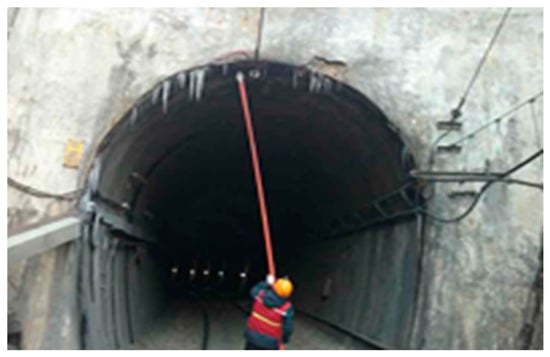
Figure 1.
Icicle removal using manpower. Adapted with permission from Ref. [6]. Copyright 2021 by Korea Railroad Research Institute all rights reserved.
Some prevention methods against freezing have been applied in Norway, Japan, and Korea to decrease the freezing damage experienced on tunnels in cold regions. The adiabatic method has been adopted in Japan to prevent freezing-induced damage [8]. Inokuma and Inano [9] found that 24% of Japanese road tunnels were damaged, and 58.7% of tunnels had water leakage. It was investigated that freezing or frost is the primary cause of tunnel damage, accounting for 38.2%. In Hokkaido, one of the coldest regions in Japan, freezing or frost damage was detected at a rate of 90% or above [10]. In Norway, injecting repair material, attaching the aluminum sheets for insulation and concrete lining with waterproof membranes are used for frost protection on tunnels [11]. Those methods, however, cannot be judged as fundamentally preventing the formation of water leakage and draining the leaked water.
In Korea, fan heater systems were suggested for removing icicle formations [12,13,14]. The fan heater methods, however, have low thermal efficiency and significant power consumption. Through numerous amounts of research on preventing and removing icicle formations in railway tunnels, the automated icicle removal device was installed and has been operated in Korea, as shown in Figure 2a. This system consists of a few heating parts and a control part. Although the icicle removal device had been operated in tunnels, water leakage was constantly found at the joint part of the device. In addition, the leakage water led to the icicles forming on the exterior of the system, as shown in Figure 2b. When these icicles melt, the water may flow through the holes in the heating plate and form icicles again. In addition, the bolt of the joint part for the icicle removal device may fall onto the tracks and cause an accident.

Figure 2.
Examples of conventional automated icicle removal device installations: (a) example installation of ordinary icicle removal device; (b) icicle formation on the joint part of an icicle removal device.
Another problem caused by water leakage in old tunnels is the clogging of drain aperture. However, Korea Institute of Construction Technology [15] had investigated the reduced drain function of old railway and subway tunnels in Korea and reported that intense clogging at the drainageways may cause severe damage of the tunnel. Therefore, a large amount of budget must be invested for the continuing maintenance of drainage systems and reinforcement of tunnel structures [15].
Koh et al. [16] recently developed an icicle prevention and guided drainage system. This system installs heating panels, supporting stands arranged along the tunnel and separated by a fixed distance from the tunnel surface, and guided drainageways for discharging thermally melted icicles to the outside of the tracks [16].
Based on previously developed technologies, a thawing-guided drainage system that can prevent the formation of icicles on water leakage sections and guide the drainage of leakage water has been proposed. This system is designed to fundamentally prevent the formation of icicles at the point where water leaked and consistently induce the drainage of leaked water that causes train operation impediments. The design, fabrication, and optimization of the proposed system to estimate its applicability to the old railway tunnels for icicle prevention were described in this study.
2. Design of Thawing-Guided Drainage Systems
2.1. Method of Thermal Control
If the surface of the tunnel is directly heated from the heater, deterioration and cracks in the concrete may become severe. In order not to directly transfer heat from a heater to the surface of the concrete, installing the heater at a predetermined distance from the tunnel crown has been considered. A film heater has been adopted for convenience in setting up onto the arch-shaped tunnel. Film heaters are more energy-efficient than other types of heaters because they use a thin layer of film to transfer heat. This means that less energy is required to heat the same amount of space. Additionally, film heaters have a longer life span than other types of heaters. They are also safer to use because they do not produce any fumes or emissions. They also enable preventing the formation of icicles and minimize the deterioration of concrete by generating only a small amount of heat. The control system is designed to operate multiple heaters according to the ambient temperature by connecting film heaters to a controller.
2.2. System Design
The developed thawing-guided drainage system consists of heating panels, supporting stands arranged along the tunnel surface with a fixed distance away from the tunnel surface, and the drainageways for discharging leaked water (thermally melted icicles) to the outside of the tracks. A heating panel is composed of a film heater, thermal insulator, and a steel plate. The heater installed on a steel plate supplies the heat source to prevent icicle formation.
Here, supporting stands that were designed into H-beam-shaped brackets are located at both sides of each unit heating panel and are fixed onto the crown line of the tunnel with anchors and fasteners to support the heating panels. The whole system is designed as a closed system that all fasteners are not exposed outside of, so the water leaking through those parts also directly flows to the drainageway inside the system. The conceptual design of the proposed system and a cross-sectional diagram of the supporting stand are shown in Figure 3a,b.
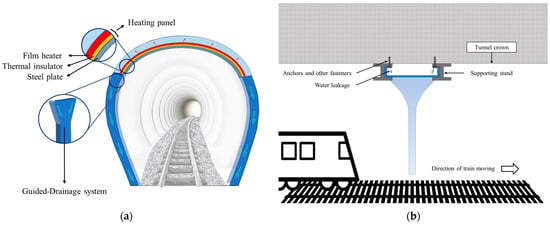
Figure 3.
The conceptual design of the thawing-guided drainage system (a) and a cross-sectional diagram of the supporting stand (b).
2.3. Lab Test for the Optimal Power Consumption Design of Heaters
The heat source to prevent icicle formation is supplied from a film heater installed on a steel panel with a thermal insulator which minimizes the thermal emission. We conducted a lab test with a chamber to optimize the heater design for low power consumption and the prevention of icicle formation. The test was conducted as follows:
- A film heater (with a measured impedance of 145 Ω) was used to minimize the size of the heating area.
- The voltage supplied to the heater was varied between 0 and 230 V to control and adjust the power of the heater.
- The change in the temperature of the system was assessed at various levels of power consumption: 100, 150, 200, 250, and 300 W. Using Equation (1) below, the measured impedance values and aimed power consumption were substituted to find the voltage:

Table 1.
Lab test conditions for designing the optimal power consumption of a film heater.
Considering the attached area of the system within the actual tunnel, a film heater was attached onto the steel plate, and a thermal insulator was applied to simulate the actual thawing-guided drainage system. The conceptual design of the testing device is shown in Figure 4.
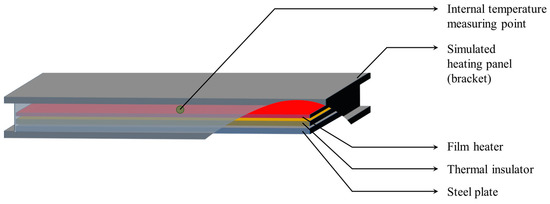
Figure 4.
Conceptual design of the testing device.
The minimum monthly mean temperatures of Bonghwa-gun and Gyeongsangbuk-do were surveyed to determine a representative winter temperature, as shown in Table 2. The measured temperature data were used to determine the internal temperature of the test chamber. The minimum monthly mean temperature of January 2012 was the lowest at −11.7 °C in the last ten years in Bongwha-gun [15]. Considering the extreme cold region, the internal temperature of the chamber was set to −15 °C.

Table 2.
Minimum monthly mean temperatures at Bonghwa-gun, Gyeongsangbuk-do, Korea in the last 10 years. (Weather data from the Korea Meteorological Administration [17]).
A voltage regulator was connected to the testing device fixed in a chamber. The voltage regulator is a device that receives the electric power from the power source and provides the adjusted electric power to the system. The maximum capacity of the voltage regulator is 10 kW, and the power can be controlled from 0 to 230 V through the installed jog. A temperature and Humidity Constant Chamber (NFEC-2005-12-043872) was used to simulate the cold weather and control the temperature, adjusting it from –40 to 80 °C and the humidity from 30 to 98%.
The voltage control device and a chamber are shown in Figure 5a,b. The test device was set in the test chamber with −15 °C for the setting temperature. The changes in the internal temperature of the testing device were measured during one hour of heating. The result for the measured internal temperature is illustrated in Figure 6 for each level of power consumption during one hour of heating at a chamber temperature of −15 °C.
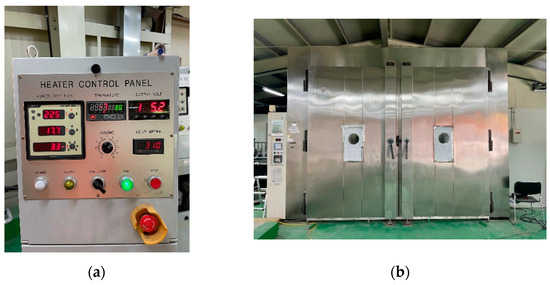
Figure 5.
The voltage control device (a) and the test chamber (b).

Figure 6.
Changes in the internal temperature of the testing device depending on power consumption.
In the case of a 100 W heater, the temperature of the system was raised to about −0.4 °C after 30 min, and 0 °C or above after 35 min. The temperature of a 150 W heater was about 3.9 °C after 30 min of operation and about 5.1 °C after one hour. After 30 min of operation, a 200 W heater raised the temperature to about 7.6 °C and raised it to about 9.0 °C after 60 min. The 250 W and 300 W heaters raised the temperature to about 12.4 and 12.0 °C, respectively, and about 14.7 °C for both with one hour of operation. The heater temperatures during heating for 15, 30, 45, and 60 min according to the electric power change are shown in the following Table 3.

Table 3.
The heater temperatures during heating for 15, 30, 45, and 60 min according to the electric power change.
At an ambient temperature of about −15 °C, the 100 W heater reached 0 °C or above after about 35 min. The temperatures of the 150 W, 200 W, 250 W, and 300 W heaters rose above 0 °C in 13 min, 9 min, 8 min, and 6 min after operating, respectively. If the power of the 100 W or less is used, it takes more than 30 min for the temperature of the heater to reach 0 °C or above. Therefore, it is judged that more than 150 W of power is necessary. The unit power consumption of the heater for the developed system was specified at 150 W.
3. Field Test
3.1. Field Location
The Seungbu Tunnel, located in Socheon-myeon, Bonghwa-gun, Gyeongsangbuk-do, was chosen for the field test of the thawing-guided drainage system. This tunnel is horseshoe-shaped and has been operated since 1956 as a single line which is located within the Yeongdong Line by Korea Railroad. Investigations of the tunnel showed deteriorated damages such as cracks, scaling, and delamination across the crown surface of the tunnel. An external view of the tunnel and icicle formation due to the water leakage from the cracks in the tunnel is presented in Figure 7a,b, respectively.

Figure 7.
Photographs of Seungbu tunnel: (a) the external view of Seungbu tunnel; (b) icicle formation in Seungbu tunnel.
Cracks, spalling, efflorescence, and the deterioration of the concrete surface have been observed throughout the tunnel lining in Seungbu tunnel. At a point of about 50 m from the tunnel entrance, the cracks on the crown line were noticeably observed where icicles had formed due to water leakage at lower temperatures during winter. This icicle formation area was determined as the location for the installation of a thawing-guided drainage system.
3.2. System Fabrication
For easy construction and maintenance, a thawing-guided drainage system was designed to be a modular structure which enables the entire system to be easily assembled and disassembled. Additionally, the height of a bracket to support the heating panel was determined to be 5 cm, considering the structure gauge to ensure safe train operations. The designed system comprises several modular panels, each consisting of a heating panel which includes a 220 V supply, 60 Hz thin film heater, and insulating material. The guided drainage system is tailored to the tunnel for the field test. A hopper was fabricated for gathering water leakage (thermally melted icicles) from the heating section, and the drainageway was fixed to the side of the tunnel, perpendicular to the hopper, to guide water leakage into the drainageway at the side of the tunnel. The controller has been designed to adjust the voltage up to 230 V to estimate the optimal thermal power consumption of the system. Based on the result of the lab test, which was described in Section 2.3, the electric power controller has been designed to monitor with gradual increases at 50 W increments.
The system was fabricated and installed in the space between the tunnel crown and the catenary. Its height (thickness of the system) was determined by the requirements for the train’s safe operation (structure gauge). In other words, the clearance between the crown panel and the heating panel was specified within the limits to ensure operational safety.
3.3. System Installation
For the field test, five heating panels with brackets for support and a control panel for adjusting the temperature were installed in Seungbu tunnel. The system has been installed at a point about 50 m from the tunnel entrance, where cracks appeared on the crown line of the tunnel (the area of icicle formation in Figure 8b). The views before and after installation of the system are shown in Figure 8a,b, alongside a thermal image of the installation during operation in Figure 8c.

Figure 8.
Installation of thawing-guided drainage system: (a) location of installation in Seungbu tunnel (location of crack); (b) system installation; (c) infrared image of operating system.
A device for remote monitoring has been installed, and a thermal cut-off function that automatically shuts off the heater according to the temperature has been installed. This enables minimizing the use of electric power to prevent icicle formation.
3.4. System Monitoring
Monitoring of the developed system installed at Seungbu tunnel, was performed from 22 December 2021 for three weeks in order to estimate its applicability. The thawing-guided drainage system was operated with 150 W of power, based on the lab test for optimal electric power consumption. The internal temperature of the thawing-guided drainage system and the ambient temperature are illustrated in Figure 9. The maximum, minimum, and average values of the internal temperature of the system and the ambient temperature for each day over the 3-week test duration are arranged in Table 4.
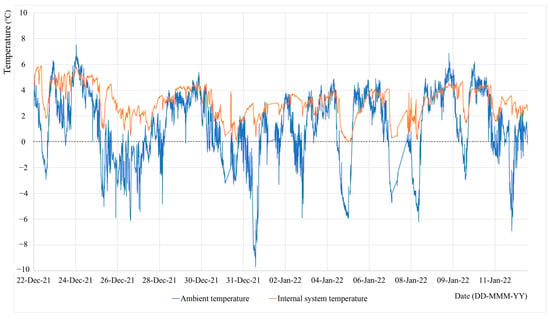
Figure 9.
The recorded ambient temperature and the internal system temperature (at the field test site) over the 3-week test duration.

Table 4.
The maximum, minimum, and average values of the internal temperature of the system and the ambient temperature over the 3-week test duration.
Although the anti-freezing effect was confirmed because the average internal temperature was above 0 °C, the temperature temporarily dropped below 0 °C for the whole test period. For example, on day 2, the ambient temperature dropped up to −2.9 °C, and the internal system temperature simultaneously indicated a temperature lower than 0 °C. The internal temperature of the system indicated 0.1 °C when the ambient temperature was lowest at −9.7 °C during the test period. It is remarkable that the internal temperature of the system was maintained above 0 °C over the 3-week test period. The average internal temperature of the internal system for 3-week test period was 3.1 °C, and the ambient temperature was 1.2 °C. Therefore, a 150 W heater prevents the icing of leakage water in the conditions of Seungbu tunnel at which the field test was conducted.
After the 3-week test period, a visual inspection was performed to verify the overall operating conditions. In terms of the inspection of component stability, there was no component separation inside and outside the system. In consequence of the visual inspection, neither icicles nor leaked water were found in the exterior of the system. Consequently, it was judged that the water had been stably drained through the drainageways. The proposed system was applied to the operational railway line, and thus, the operational safety of the system was also verified during the field test period.
4. Discussion
The thawing-guided drainage system was installed in an old railway operational tunnel the Korea Railroad Corporation and its applicability was verified in this paper. About 30 % of railway tunnels in Korea are more than 50 years old, and new tunnels continue to be constructed [3]. Although Korea Railroad Corporation has already adopted and operated icicle prevention devices which are basically heating panels, the icicles are continuously formed. This necessitates an increase manpower in order to remove the icicles in railway tunnels every year. Moreover, the railway operators not only in Korea but also all around the world have faced this issue.
The newly proposed system is an innovative system that improves the problems found in the conventional icicle prevention device and induces drainage to be discharged to the outside of the track. In the conventional device, icicle formation on the heating panel was prevented; however, the water leaking could not be controlled around anchors and other fasteners. The leaked water causes icicle formation at the area where an anchor is embedded; therefore, the conventional method cannot fundamentally prevent the formation of icicles. In addition, adiabatic methods that are adopted and operated in Japan and Norway, such as a thermal insulation method and aluminum insulation sheets, may prevent icicle formation; however, they cannot drain leaked water to the outside of the track. The reverse icicle formed on the track or the catenary with leaked water may cause electrical failures in railway operation. The proposed system is designed as a closed system that all the fasteners are not exposed outside of. This method is an efficient solution as the leaked water directly flows to the outside of the tracks.
5. Conclusions
The performance of concrete structures degrades over time due to general aging. In Korea, the number of road and railway tunnels has rapidly increased. Due to terrain, geology, and local conditions, tunnels experience concrete deterioration and water leakage. In cold weather especially, safety measures are necessary to deal with water leakage occurring from cracks in old tunnels, which form icicles on the crown lines and frost (inverse icicles) on the tracks. A thawing-guided drainage system which prevents the formation of icicles has been proposed in this study. The system consists of heating panels along the tunnel surface, supporting stands arranged at consistent intervals along the tunnel surface, and guided drainageways that induce the drainage of leakage towards the side of the tunnel (outside of the track).
The system has been designed and fabricated for verifying its field applicability through lab and field tests. In lab conditions, the prototype system was operated with 100 W of power, and then the power was gradually increased at 50 W increments up to 300 W of power. It was evident that the heating by the thawing-guided drainage system increased the internal temperature of the system irrespective of the applied power. Considering the minimum mean temperature of the installation site and simulating the extreme cold region, the internal temperature of the chamber was set to −15 °C. The temperature distribution of a 100 W heater shows that the internal temperature was below 0 °C until after 34 min. Although the anti-freezing effect was confirmed because the average internal temperature was above 0 °C, the temperature temporarily dropped below 0 °C at a certain time. The system successfully maintained an internal temperature of 0 °C or above, even with an external air temperature of −15 °C that replicates extreme cold during winter.
For the field test, the thawing-guided drainage system composed of heating panels, supporting stands, and the drainageways for discharging leaked water has been fabricated. The system uses a 150 W heating module, which fundamentally prevents the formation of icicles from cracks in Seoungbu tunnel and induces the drainage of thermally melted icicles to the outside of the track. Through the field test, it has been investigated that the thawing-guided drainage system had also maintained an internal temperature of 0 °C or above even at ambient temperatures of about −10 °C, and furthermore, the system effectively drained water leakage (thermally melted icicles).
The proposed system was installed on the operational railway line in the field test. Through the field test, the icicle prevention performance was verified by maintaining the internal temperature above 0 °C over the whole 3-week test period, even at an ambient temperature of about −10 °C. The operational safety was also verified as there was no component separation inside and outside the system. Therefore, it is judged that the applicability of the developed system has been verified in consideration of the following three aspects: usability in the operational railway line, effectiveness for thawing and guided-drainage performances, and operational safety without interrupting railway operation after installation.
In this study, the applicability of the thawing-guided drainage system to the old railway tunnel was tested and verified. This system, however, can be applied not only to railway tunnels but to road tunnels and various infrastructures that require efficient thawing and drainage even in extreme cold regions. Even though the transportation technologies are steadily becoming more sophisticated, such as a subsonic capsule train or hyperloop system, sustainable thawing and drainage technologies for the old railway infrastructure are constantly required.
Author Contributions
Conceptualization, T.K.; methodology, S.K., H.Y. and T.K.; validation, S.K., T.K. and H.Y.; formal analysis, S.K. and T.K.; investigation, S.K. and H.Y.; resources, S.K. and T.K.; data curation, S.K. and H.Y.; writing—original draft preparation, S.K.; writing—review and editing, T.K. and H.Y.; visualization, S.K.; supervision, T.K.; project administration, T.K.; funding acquisition, T.K. All authors have read and agreed to the published version of the manuscript.
Funding
This work is supported by a Korea Agency for Infrastructure Technology Advancement (KAIA) grant funded by the Ministry of Land, Infrastructure and Transport (Grant 22RTRP-B146020-05).
Institutional Review Board Statement
Not applicable.
Informed Consent Statement
Not applicable.
Data Availability Statement
Not applicable.
Conflicts of Interest
The authors declare no conflict of interest.
References
- Korea Statistical Information Service (Ministry of Land, Infrastructure and Transport). Current State of Road Bridges and Tunnels in 2021. Available online: https://kosis.kr/ (accessed on 1 October 2022).
- Korea National Railway. Current State of Structure. Available online: https://kosis.kr/ (accessed on 1 October 2022).
- Korea Railroad. Current State of Structure Service in 2021; Korea Railroad Corporation, Civil Engineering Planning Department: Daejeon, Republic of Korea, 2021; pp. 42–43. [Google Scholar]
- Oggeri, C.; Fenoglio, T.M.; Vinai, R. Tunnel spoil classification and applicability of lime addition in weak formations for muck reuse. Tunn. Undergr. Space Technol. 2014, 44, 97–107. [Google Scholar] [CrossRef]
- Koh, K.T. Design and preventive measures for frost resistance of concrete. Mag. Korea Concr. Inst. 2001, 13, 44–51. [Google Scholar] [CrossRef]
- Kim, S.H.; Shin, S.H.; Lee, J.G. Research Report: Investigation and Analysis of Winter Disorder in Tunnel Structures of General Railways; Korea Railroad Cooperation: Daejeon, Republic of Korea, 2021. [Google Scholar]
- Gwon, H.B. Current status of railway damage in winter and prevention technologies. Korean Soc. Railw. Railw. J. 2015, 18, 26–43. [Google Scholar]
- Okada, K. Study for Icicle Prevention by Adiabatic Treatment in Railway Tunnel. Railw. Tech. Res. Inst. Q. Rep. 1987, 28, 1–4. [Google Scholar]
- Asakura, T.; Kojima, Y.; Onoda, S. Development of reinforcement and repair methods for railway tunnel. Railw. Tech. Res. Inst. Q. Rep. 1991, 32, 163–173. [Google Scholar]
- Inokuma, A.; Inano, S. Road tunnels in Japan: Deterioration and countermeasures. Tunn. Undergr. Space Technol. 1996, 11, 305–309. [Google Scholar] [CrossRef]
- Pedersen, K. Frost Protection of Norwegian Road Tunnels. Frost I Jord 1977, 19, 27–33. [Google Scholar]
- Baesan Engineering Inc.; Kim, S.J.; Lee, C. Moving Hot Blower System for Preventing from Creating Icicle. Korea Patent 1018094780000, 11 December 2017. [Google Scholar]
- Kim, S.J.; Lee, C. System of Preventing from Creating Icicle in Tunnel. Korea Patent 1017825330000, 21 September 2017. [Google Scholar]
- Korea Authority for Land & Infrastructure Safety. Freezing Preventing System for Tunnel Entrance. Korea Patent 1019540210000, 25 February 2018. [Google Scholar]
- Jung, H.S.; Han, Y.S.; Chung, S.R.; Chun, B.S.; Lee, Y.J. Evaluation of advanced drainage treatment for old tunnel drainage system in Korea. Tunn. Undergr. Space Technol. 2013, 38, 476–486. [Google Scholar] [CrossRef]
- Koh, T.H.; Sagong, M.; Yoo, H.J.; Park, J.W.; Kim, C.J. Heating Induced Drainage Lining System for Preventing Icicle Damage due to Leakage in Tunnels. Korea Patent 1023040200000, 14 September 2021. [Google Scholar]
- Korea Meteorological Administration. Available online: https://www.kma.go.kr/kma/ (accessed on 29 September 2022).
Publisher’s Note: MDPI stays neutral with regard to jurisdictional claims in published maps and institutional affiliations. |
© 2022 by the authors. Licensee MDPI, Basel, Switzerland. This article is an open access article distributed under the terms and conditions of the Creative Commons Attribution (CC BY) license (https://creativecommons.org/licenses/by/4.0/).